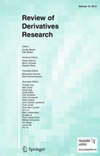
Review of Derivatives Research
REV DERIV RES
期刊介绍
The proliferation of derivative assets during the past two decades is unprecedented. With this growth in derivatives comes the need for financial institutions, institutional investors, and corporations to use sophisticated quantitative techniques to take full advantage of the spectrum of these new financial instruments. Academic research has significantly contributed to our understanding of derivative assets and markets. The growth of derivative asset markets has been accompanied by a commensurate growth in the volume of scientific research. The Review of Derivatives Research provides an international forum for researchers involved in the general areas of derivative assets. The Review publishes high-quality articles dealing with the pricing and hedging of derivative assets on any underlying asset (commodity, interest rate, currency, equity, real estate, traded or non-traded, etc.). Specific topics include but are not limited to: econometric analyses of derivative markets (efficiency, anomalies, performance, etc.) analysis of swap markets market microstructure and volatility issues regulatory and taxation issues credit risk new areas of applications such as corporate finance (capital budgeting, debt innovations), international trade (tariffs and quotas), banking and insurance (embedded options, asset-liability management) risk-sharing issues and the design of optimal derivative securities risk management, management and control valuation and analysis of the options embedded in capital projects valuation and hedging of exotic options new areas for further development (i.e. natural resources, environmental economics. The Review has a double-blind refereeing process. In contrast to the delays in the decision making and publication processes of many current journals, the Review will provide authors with an initial decision within nine weeks of receipt of the manuscript and a goal of publication within six months after acceptance. Finally, a section of the journal is available for rapid publication on `hot' issues in the market, small technical pieces, and timely essays related to pending legislation and policy. Officially cited as: Rev Deriv Res
在过去的20年里,衍生品资产的激增是前所未有的。随着衍生品的增长,金融机构、机构投资者和企业需要使用复杂的量化技术来充分利用这些新的金融工具。学术研究极大地促进了我们对衍生资产和市场的理解。衍生资产市场的增长伴随着科学研究数量的相应增长。《衍生工具研究评论》为从事衍生资产一般领域研究的研究人员提供了一个国际论坛。该评论发表高质量的文章,涉及任何基础资产(商品、利率、货币、股票、真实的地产、交易或非交易等)衍生资产的定价和对冲。具体主题包括但不限于:衍生市场的计量经济学分析(效率、异常、绩效等)分析掉期市场市场微观结构和波动性问题监管和税收问题信贷风险新的应用领域,如公司融资(资本预算、债务创新)、国际贸易(关税和配额)、银行和保险(嵌入式期权,资产负债管理)风险分担问题和最优衍生证券风险管理的设计,管理和控制资本项目中所含期权的估值和分析外来期权的估值和对冲进一步开发的新领域(即自然资源、环境经济学)。审查采用双盲评审流程。与许多现有期刊在决策和出版过程中的延迟形成对比的是,《评论》将在收到手稿后9周内向作者提供初步决定,并在接受后6个月内提供出版目标。最后,该杂志的一个部分可用于快速出版市场上的“热点”问题、小型技术文章以及与未决立法和政策有关的及时论文。正式引用为:收入衍生结果
| 年发文量 | 8 |
| 国人发稿量 | - |
| 国人发文占比 | 0% |
| 自引率 | 0.0% |
| 平均录取率 | - |
| 平均审稿周期 | - |
| 版面费 | US$2780 |
| 偏重研究方向 | Multiple- |
| 期刊官网 | https://www.springer.com/11147/?utm_medium=display&utm_source=letpub&utm_content=text_link&utm_term=null&utm_campaign=HSSR_11147_AWA1_CN_CNPL_letpb_mp |
| 投稿链接 | https://www.editorialmanager.com/redr |
质量指标占比
| 研究类文章占比 | OA被引用占比 | 撤稿占比 | 出版后修正文章占比 |
|---|---|---|---|
| 100.00% | 57.14% | 0.00% | 0.00% |
相关指数
期刊预警不是论文评价,更不是否定预警期刊发表的每项成果。《国际期刊预警名单(试行)》旨在提醒科研人员审慎选择成果发表平台、提示出版机构强化期刊质量管理。
预警期刊的识别采用定性与定量相结合的方法。通过专家咨询确立分析维度及评价指标,而后基于指标客观数据产生具体名单。
具体而言,就是通过综合评判期刊载文量、作者国际化程度、拒稿率、论文处理费(APC)、期刊超越指数、自引率、撤稿信息等,找出那些具备风险特征、具有潜在质量问题的学术期刊。最后,依据各刊数据差异,将预警级别分为高、中、低三档,风险指数依次减弱。
《国际期刊预警名单(试行)》确定原则是客观、审慎、开放。期刊分区表团队期待与科研界、学术出版机构一起,夯实科学精神,打造气正风清的学术诚信环境!真诚欢迎各界就预警名单的分析维度、使用方案、值得关切的期刊等提出建议!
预警情况
查看说明
| 时间 | 预警情况 |
|---|---|
| 2025年03月发布的2025版 | 不在预警名单中 |
| 2024年02月发布的2024版 | 不在预警名单中 |
| 2023年01月发布的2023版 | 不在预警名单中 |
| 2021年12月发布的2021版 | 不在预警名单中 |
| 2020年12月发布的2020版 | 不在预警名单中 |
JCR分区 WOS分区等级:Q3区
| 版本 | 按学科 | 分区 |
|---|---|---|
|
WOS期刊SCI分区
WOS期刊SCI分区是指SCI官方(Web of Science)为每个学科内的期刊按照IF数值排
序,将期刊按照四等分的方法划分的Q1-Q4等级,Q1代表质量最高,即常说的1区期刊。
(2021-2022年最新版)
|
||
| ECONOMICS | Q4 | |
| BUSINESS, FINANCE | Q4 |
关于2019年中科院分区升级版(试行)
分区表升级版(试行)旨在解决期刊学科体系划分与学科发展以及融合趋势的不相容问题。由于学科交叉在当代科研活动的趋势愈发显著,学科体系构建容易引发争议。为了打破学科体系给期刊评价带来的桎梏,“升级版方案”首先构建了论文层级的主题体系,然后分别计算每篇论文在所属主题的影响力,最后汇总各期刊每篇论文分值,得到“期刊超越指数”,作为分区依据。
分区表升级版(试行)的优势:一是论文层级的主题体系既能体现学科交叉特点,又可以精准揭示期刊载文的多学科性;二是采用“期刊超越指数”替代影响因子指标,解决了影响因子数学性质缺陷对评价结果的干扰。整体而言,分区表升级版(试行)突破了期刊评价中学科体系构建、评价指标选择等瓶颈问题,能够更为全面地揭示学术期刊的影响力,为科研评价“去四唯”提供解决思路。相关研究成果经过国际同行的认可,已经发表在科学计量学领域国际重要期刊。
《2019年中国科学院文献情报中心期刊分区表升级版(试行)》首次将社会科学引文数据库(SSCI)期刊纳入到分区评估中。升级版分区表(试行)设置了包括自然科学和社会科学在内的18个大类学科。基础版和升级版(试行)将过渡共存三年时间,推测在此期间各大高校和科研院所仍可能会以基础版为考核参考标准。 提示:中科院分区官方微信公众号“fenqubiao”仅提供基础版数据查询,暂无升级版数据,请注意区分。
中科院分区
查看说明
| 版本 | 大类学科 | 小类学科 | Top期刊 | 综述期刊 |
|---|---|---|---|---|
|
经济学
4区
|
ECONOMICS
经济学
4区
BUSINESS, FINANCE
商业:财政与金融
4区
|
未知 | 未知 | |
|
2021年12月
升级版
|
经济学
4区
|
ECONOMICS
经济学
4区
BUSINESS, FINANCE
商业:财政与金融
4区
|
未知 | 未知 |
|
2020年12月
旧的升级版
|
经济学
4区
|
ECONOMICS
经济学
4区
BUSINESS, FINANCE
商业:财政与金融
4区
|
未知 | 未知 |
|
2022年12月
最新升级版
|
经济学
4区
|
ECONOMICS
经济学
4区
BUSINESS, FINANCE
商业:财政与金融
4区
|
未知 | 未知 |














